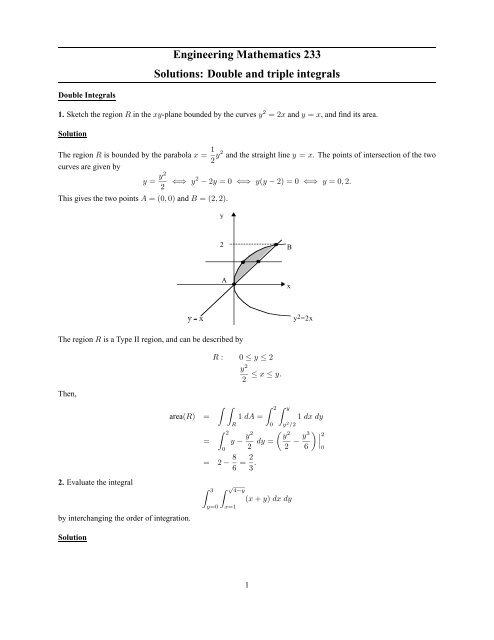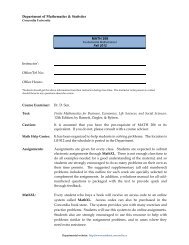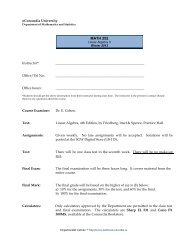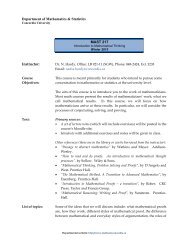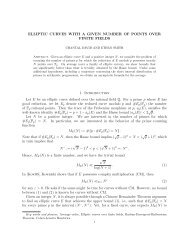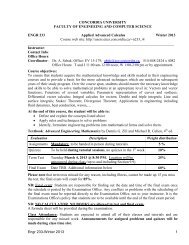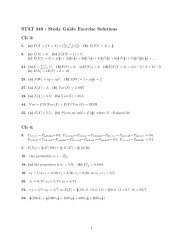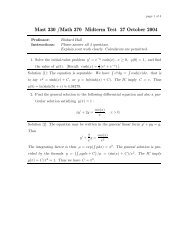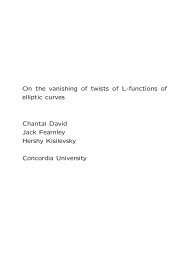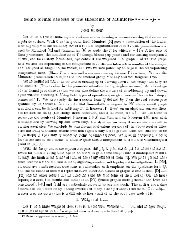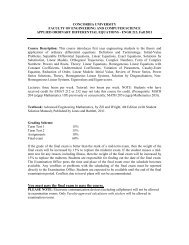Engineering Mathematics 233 Solutions: Double and triple integrals
Engineering Mathematics 233 Solutions: Double and triple integrals
Engineering Mathematics 233 Solutions: Double and triple integrals
Create successful ePaper yourself
Turn your PDF publications into a flip-book with our unique Google optimized e-Paper software.
The region of integration is the Type II region RR : 0 ≤ y ≤ 31 ≤ x ≤ √ 4 − y.x=143Rx1x2= 4 −xyWe havex = √ 4 − y ⇒ x 2 = 4 − y ⇔ y = 4 − x 2 .Then, from the drawing above, we can rewrite the region R as the Type I regionR : 1 ≤ x ≤ 20 ≤ y ≤ 4 − x 2 .Then,∫ 3∫ √ 4−yy=0 x=1(x + y) dx dy ====∫ 2x=1∫ 21∫ 21∫ 4−x2y=0(xy + y22(2x 2 − x44(x + y) dy dx) ∣∣∣ 4−x 204x − x 3 + 16 − 8x2 + x 4dx2)4x3 ∣∣∣+ 8x −3 + x5 2101 = 24160 .3. Find the volume of the region of R 3 bounded by the paraboloid z = x 2 + y 2 <strong>and</strong> by the planes z = 0, x = −a,x = a, y = −a <strong>and</strong> y = a.Solution2
Let S be the 3D region bounded by the paraboloid <strong>and</strong> the planes.za-a-a aregion RyThen,x∫ ∫volume(S) =where R is the projection of S in the xy-plane, i.e.Then,volume(S) == 4= 4∫ ∫R :R∫ a ∫ a0∫ a0( 2a4= 43Rx 2 + y 2 dA =(x 2 + y 2 − 0 ) dA,−a ≤ x ≤ a−a ≤ y ≤ a.∫ a ∫ a−a−a∫ ax 2 + y 2 dy dx) ∣∣∣x 2 + y 2 dy dx = 4(x 2 y + y3 a00 3dx0(x 2 a + a3 x 3 )3 dx = 4 a3 + a3 x ∣∣∣ a3 0)= 8a43 .∫ ∫4. Evaluate√x2 + y 2 dA, where R is the region of the plane given by x 2 + y 2 ≤ a 2 .SolutionRThe region R <strong>and</strong> the integr<strong>and</strong> √ x 2 + y 2 are best described with polar coordinates (r, θ). In those coordinates, theregion R, which is the region inside the circle x 2 + y 2 = a 2 , becomesThen,∫ ∫RR :√x2 + y 2 dA =0 ≤ r ≤ a0 ≤ θ ≤ 2π.==∫ 2π ∫ a0 0∫ 2π ∫ a0∫ 2π00a 33r r dr dθr 2 dr dθdθ =2πa33 .3
∫ ∫5. EvaluateSolutionRe −(x2 +y 2) dA, where R is the region of 4. above.Using polar coordinates again, we write∫ ∫e −(x2 +y 2) dA =R==∫ 2π ∫ ae −r20 0∫ 2π0∫ 2π0e −r2−2∣ a 0 dθr dr dθ12 (1 − e−a2 ) dθ = π(1 − e −a2 ).6. Evaluate the integral ∫ 1 ∫ 1ye x2 dx dy. Hint: First reverse the order of integration.0 y 2SolutionIf we try to evaluate the integral as written above, then the first step is to compute the indefinite integral∫e x2dx.But e x2does not have an indefinite integral that can be written in terms of elementary functions. Then, we will fistreverse the order of integration. The region of integration is the Type II regionR : 0 ≤ y ≤ 1yy 2 ≤ x ≤ 1.1x=y 21xThen, R can also be described as the Type I regionThis givesR : 0 ≤ x ≤ 10 ≤ y ≤ √ x.∫ 1 ∫ 10y 2 ye x2 dx dy === 1 2= 1 2∫ 1 ∫ √ xye x20 0∫ 1( y20∫ 1xe x20(e x22) ∣∣∣ √ x2 ex2 0) ∣∣∣ 1dx0dy dxdx= 1 (e − 1).44
7. Find the volume of the tetrahedron bounded by the coordinate axes <strong>and</strong> the plane 3x + 6y + 4z = 12.SolutionWe have to find the volume of the tetrahedron S bounded by the plane3x + 6y + 4z = 12 ⇐⇒ z =12 − 3x − 6y4<strong>and</strong> the coordinate axes. This is the portion of the plane in the first octant, as one can see from Picture (1).z3Region Rplane3x + 6y + 4z = 12 3line 3x + 6y = 12y2y44 Rxx(1) (2)Then, we have∫ ∫volume(S) =R12 − 3x − 6y4where R is the projection of the tetrahedron in the xy-plane. Then, R is the Type I region (see Picture (2))dA,Finally, this givesR : 0 ≤ x ≤ 412 − 3x0 ≤ y ≤ .6volume(S) = 1 4= 1 4= 1 4∫ 4 ∫ 12−3x/60∫ 40∫ 40∫ 40(12 − 3x − 6y) dy dx((12 − 3x)y − 3y2 ) ∣ ∣ ∣2− x 2((12 − 3x) 2 − x )− 32= 1 34 0 4 x2 − 6x + 12 dx= 1 ( ) x3∣∣∣4 4 − 43x2 + 12x = 4.00dx(2 − x 2) 2dx5
8. Evaluate the integral∫ 1∫ √ 4−y 2 √x2 + y 2 dx dy.Hint: Use polar coordinates.Solution0√3 yThe region R of integration is the Type II regionR : 0 ≤ y ≤ 1√3 y ≤ x ≤√4 − y2We havex = √ 4 − y 2 ⇒ x 2 = 4 − y 2 ⇔ x 2 + y 2 = 4.Then, x varies between the straight line x = √ 3 y <strong>and</strong> the circle x 2 + y 2 = 4.The region R is1P = ( 3, 1)2In polar coordinates, the region R isR : 0 ≤ r ≤ 20 ≤ θ ≤ α,where α is the angle made by the straight line x = √ 3 y. The straight line <strong>and</strong> the cicle meet at the points(√ ) 23y + y 2 = 4 ⇐⇒ 4y 2 = 4 ⇐⇒ y 2 = 1 ⇐⇒ y = ±1.The intersection point in the first quadrant is then P = ( √ 3, 1) = (2 cos α, 2 sin α). Then,( 1α = arcsin =2)π 6 .Finally, the integr<strong>and</strong> √ x 2 + y 2 is r in polar coordinates. This gives∫ 10∫ √ 4−y 2√3y√x2 + y 2 dx dy === π 6∫ π/6 ∫ 20∫ π/600r 33r r dr dθ∣ 2 0 dθ83 = 4π 9 .9. Find the volume below the surface z = x 2 + y 2 , above the plane z = 0, <strong>and</strong> inside the cylinder x 2 + y 2 = 2y.6
SolutionCompleting the squares, we rewrite the equation of the cylinder asx 2 + y 2 = 2y ⇐⇒ x 2 + (y 2 − 2y) = 0 ⇐⇒ x 2 + (y − 1) 2 = 1.The base of the cylinder is then the circle of radius 1 centered at (0, 1). Then, we have to find the volume of the 3Dregion:zz = x 2 + y 2volumeyxregion RFrom the picture above, we write∫ ∫V = x 2 + y 2 dA,Rwhere R is the projection of the 3D region in the plane, i.e. the circle x 2 + y 2 = 2y. Using polar coordinates, thisgives∫ ∫V = r 2 r dr dθ.In polar coordinates x = r cos θ <strong>and</strong> y = r sin θ, the circle writes asx 2 + y 2 = 2y ⇐⇒ r 2 = 2r sin θ ⇐⇒ r = 2 sin θ,<strong>and</strong> R is the regionRR :0 ≤ θ ≤ π0 ≤ r ≤ 2 sin θ.Then,V =∫ π ∫ 2 sin θ0 0∫ πr 3 dr dθ == 4 sin 4 θ dθ = 40( ) 3π= 4 = 3π 8 2 .∫ π0r 44∣ 2 sin θdθ0( 3θ8 − 1 1∣ ∣∣sin 2θ +4 32 sin 4θ π0)Triple Integrals10. Evaluate ∫ 1∫ 1 ∫ 2x=0 y=0z= √ x 2 +y 2 xyz dz dy dx.7
Solution∫ 1 ∫ 100∫ 2√x2 +y 2 xyz dz dy dx =======∫ 1 ∫ 10 0∫ 1 ∫ 10 0∫ 1 ∫ 10∫ 10∫ 10∫ 10xyz 2∣ 22√ dy dxz= x 2 +y 22xy − xy(x2 + y 2 )2dy dx2xy − x3 y0 2 − y3 xdy dx2(xy 2 − x3 y 2 )− y4 x ∣∣∣ 14 8dx0x − x34 − x 8 dx7x8 − x34 dx) ∣∣∣ 1( 7x216 − x416= 716 − 116 = 3 8 .011. Find the mass of the 3D region B given byx 2 + y 2 + z 2 ≤ 4, x ≥ 0, y ≥ 0, z ≥ 0,if the density is equal to xyz.SolutionWe have∫ ∫ ∫mass(B) = xyz dV,<strong>and</strong> the region B is the portion of the sphere of radius 2 in the first octant.Bzspherex 2 + y 2 + z 2 = 4yyxxxx 2 + y 2 ≤ 48
3D region B2D region RThen, B can be described as0 ≤ z ≤ √ 4 − x 2 − y 2 , for all (x, y) ∈ R,where R is the projection of B in the xy-plane. Describing R as a Type I region, this givesThen,mass(B) === 1 2= 1 2= 1 2= 1 2B : 0 ≤ x ≤ 2∫ 2 ∫ √ 4−x 20 0∫ 2 ∫ √ 4−x 20 0∫ 2 ∫ √ 4−x 20 ≤ y ≤ √ 4 − x 20 ≤ z ≤ √ 4 − x 2 − y 2 .∫ √ 4−x 2 −y 2xyz dz dy dx00 0∫ 2 ∫ √ 4−x 20∫ 20∫ 200∫ 2x 5(xy z22(2xy 2 − x3 y 2) ∣∣∣√4−x2 −y 2dy dx0xy(4 − x 2 − y 2 ) dy dx4xy − x 3 y − y 3 x dy dx22x(4 − x 2 ) − x3 (4 − x 2 )2= 1 2 0 4 − 2x3 + 4x dx= 1 ( ) x6∣∣∣2 24 − x42 + 4x2 22 0= 1 ( )642 24 − 8 + 8 = 4 3 .)− y4 x ∣∣∣√4−x 2dx4 0− (4 − x2 ) 2 x4dx12. Find the volume of the region B bounded by the paraboloid z = 4 − x 2 − y 2 <strong>and</strong> the xy-plane.Solution9
∫ ∫ ∫We have volume(B) = 1 dV.Bz(0,0,4)z = 4 - x 2 - y 2yxRThen, B can be described as0 ≤ z ≤ 4 − x 2 − y 2 , for all (x, y) ∈ R,where R is the projection of B in the xy-plane. Then, R is the interior of the circle x 2 + y 2 = 4. In polar coordinates,the region R isR :0 ≤ θ ≤ 2π0 ≤ r ≤ 2,<strong>and</strong> in cylindrical coordinates, the region B isThen,volume(B) =B : 0 ≤ z ≤ (4 − r 2 )== 2π= 2π0 ≤ θ ≤ 2π0 ≤ r ≤ 2.∫ 2π ∫ 2 ∫ 4−r20 0∫ 2π ∫ 20 0∫ 200r dz dr dθ(4 − r 2 )r dr dθ4r − r 3 dr)∣= 2π(4) = 8π.(2r 2 − r44∣ 2 013. Find the center of gravity of the region in 12., assuming constant density σ.SolutionBy symmetry, x = y = 0. Also, as the density is d(x, y, z) = σ,∫ ∫ ∫∫ ∫ ∫d(x, y, z)z dV σBz = ∫ ∫ ∫= ∫ ∫ ∫d(x, y, z) dV σ=∫ ∫ ∫BBz dVvolume(B)= 1 ∫ ∫ ∫z dV .8π B10BBz dV1 dV
Using the description of the region B in cylindrical coordinates of 12., we get∫ ∫ ∫Bz dV ==∫ 2π ∫ 2 ∫ 4−r20 0∫ 2π ∫ 200∫ 20z r dz dr dθ(4 − r 2 ) 2r dr dθ2= 2π 16r − 8r 3 + r 5 dr2 0)= π(8r 2 − 2r 4 + r6∣ 2 = 32 6 0 3 π.Then,z = 1 ( ) 328π 3 π = 4 3 .14. Evaluate ∫ ∫ ∫√x2 + y 2 + z 2 dV,where B is the region bounded by the plane z = 3 <strong>and</strong> the cone z = √ x 2 + y 2 .SolutionWe will use the spherical coordinateszBφρyxθto describe the region B. In those coordinates,x = ρ sin φ cos θy = ρ sin φ sin θz = ρ cos φ.Then, the cone z = √ x 2 + y 2 writes asρ cos φ = ρ sin φ ⇐⇒ sin φcos φ = tan φ = 1 ⇐⇒ φ = π 4 ,the plane z = 3 as3 = ρ cos φ ⇐⇒ ρ = 3cos φ ,11
<strong>and</strong> the region B can be described asB : 0 ≤ φ ≤ π 40 ≤ φ ≤ 2π0 ≤ ρ ≤ 3cos φ .z = 3z = x2+ y2yFinally, in spherical coordinates, √ x 2 + y 2 + z 2 = ρ.Then,∫ ∫ ∫B√x2 + y 2 + z 2 dV =x= 2π= 2π∫ 2π ∫ π/4 ∫ 3/ cos φ0 0∫ π/40∫ π/4sin φ0∫ π/40∫ 3/ cos φ0( ρ4sin φ ∣4ρ ρ 2 sin φ dρ dφ dθ3/ cos φ= 2π 34 sin φ4 0 cos 4 φ dφ= 81π ( (cos φ)−3)∣ π/42 3 0⎛(√ ) −3= 81π ⎝ 2− 1⎞6 20ρ 3 dρ dφ)dφ⎠ = 27π2(2 √ )2 − 1 .15. Evaluate ∫ ∫ ∫(x 2 + y 2 + z 2) −3/2dV,Bwhere B is the region bounded by the spheres x 2 + y 2 + z 2 = a 2 <strong>and</strong> x 2 + y 2 + z 2 = b 2 , where a > b > 0.SolutionUsing spherical coordinates, the region B between the 2 spheres can be described asB :0 ≤ θ ≤ 2π0 ≤ φ ≤ πa ≤ ρ ≤ b.12
zByxThen,∫ ∫ ∫B(x 2 + y 2 + z 2 ) −3/2 dV =∫ 2π ∫ π ∫ b0 0 a∫ π ∫ bρ −3 ρ 2 sin φ dρ dφ dθ1= 2π sin φ dρ dφ0 a ρ∫ π()= 2π ln ρ∣ b sin φ dφ0 a( ∫ b π= 2π ln sin φ dφa)0( ) b ( = 2π ln − cos φ∣∣ π )a0( b= 4π ln .a)16. Find the volume of the region B bounded above by the sphere x 2 + y 2 + z 2 = a 2 <strong>and</strong> below by the plane z = b,where a > b > 0.SolutionThe region B can be described as the set of (x, y, z) ∈ R 3 such thatb ≤ z ≤ √ a 2 − x 2 − y 213
for all (x, y) in the plane region bounded by the circle x 2 + y 2 + b 2 = a 2 ⇐⇒ x 2 + y 2 = a 2 − b 2 .(0, 0, a)Bz = bsphere x 2 + y 2 + z 2 = a 2The region B is best described in cylindrical coordinates, <strong>and</strong> this givesB : b ≤ z ≤ √ a 2 − r 20 ≤ r ≤ √ a 2 − b 20 ≤ θ ≤ 2π.Then,volume(B) ==== 2π= 2π∫ ∫ ∫1 dVB∫ 2π ∫ √ a 2 −b ∫ √ 2 a 2 −r 20 0∫ 2π ∫ √ a 2 −b 20 0∫ √ a 2 −b 2(= 2π − 1 3br dz dr dθ( √ a 2 − r 2 − b)r dr dθ√a2 − r 2 r − br dr0(√ )(a 2 − r 2 ) 3/2(3/2)(−2)− a2 −b 2br22 ∣0((b 2 ) 3/2 − (a 2 ) 3/2) − b 2 (a2 − b 2 )( a 3 − b 3) ( )= 2π − a2 b3 2 + b3 a3= 2π2 3 − a2 b2 + b3 .6)17. Sketch the region B whose volume is given by the <strong>triple</strong> integral∫ 4 ∫ (4−x)/2 ∫ (12−3x−6y)/4Rewrite the <strong>triple</strong> integral using the order of integration dV = dy dx dz.SolutionFrom the <strong>triple</strong> integral, the region B is described by0000 ≤ z ≤12 − 3x − 6y,4141 dz dy dx.
12 − 3x − 6yi.e. z varies between the planes z = 0 <strong>and</strong> z =4the region R described by⇐⇒ 3x + 6y + 4z = 12. Furthermore, (x, y) are inR :0 ≤ y ≤ 4 − x20 ≤ x ≤ 4,which is the projection of the plane 3x + 6y + 4z = 12 in the xy-plane.z(0,0,3)(0,2,0)yx(4,0,0)region RWe now use the ordre of integration dV = dy dx dz. The region B be can be described as0 ≤ y ≤12 − 3x − 4x6for all (x, z) in the region R which is the projection of B in the xz-plane. Then, R can be described asThis givesR : 0 ≤ z ≤ 3(12 − 4z)0 ≤ x ≤ .3∫ 4 ∫ (4−x)/2 ∫ (12−3x−6y)/41 dz dy dx =∫ 3 ∫ (12−4z)/3 ∫ (12−3x−4z)/60 000 001 dy dx dz.18. Evaluate ∫ ∫ ∫√x2 + y 2 dV,where B is the region lying above the xy-plane, <strong>and</strong> below cone z = 4 − √ x 2 + y 2 .SolutionThe region B be can be described as0 ≤ z ≤ 4 − √ x 2 − y 2 , for all (x, y) ∈ R,where R is the projection of B in the xy-plane. Then, R is the region inside the curve0 = 4 − √ x 2 + y 2 ⇐⇒ x 2 + y 2 = 16,B15
which is a circle of radius 4.z2 2z = 4 − x + yyxRWe then use cylindrical coordinates to describe the region B. This givesB :0 ≤ z ≤ 4 − r0 ≤ r ≤ 40 ≤ θ ≤ 2π.Then,∫ ∫ ∫√x2 + y 2 dV =B===∫ 2π ∫ 4 ∫ 4−r0 0∫ 2π ∫ 40 0∫ 2π ∫ 40∫ 2π0= 64 300r r dz dr dθr 2 (4 − r) dr dθ4r 2 − r 3 dr4r 33 − r44 ∣∫ 2π040dθdθ = 64 3 (2π).19. Evaluate the integral∫ 4 ∫ √ 16−x ∫ 2 (16−x 2 −y 2 )√x2 + y 2 dz dy dx.Hint: First convert to cylindrical coordinates.000SolutionThe region B described by the integral is the region given by 0 ≤ z ≤ (16 − x 2 − y 2 ), i.e. bounded below by the planez = 0 <strong>and</strong> above by the paraboloid z = 16−x 2 −y 2 , for all (x, y) ∈ R. For the region R, we have 0 ≤ y ≤ √ 16 − x 2 ,i.e. y varies between the straight line y = 0 <strong>and</strong> the top part of the circle x 2 + y 2 = 16. Similarly, x varies between16
the straight lines x = 0 <strong>and</strong> x = 4. Then, R is the portion of the circle x 2 + y 2 = 16 in the first quadrant.z(0,0,16)z = 16 - (x 2 + y 2 )y= 16 −2xyx3D region BR 0 42D region RThe region B is best described in cylindrical coordinates asThen,∫ 4 ∫ √ 16−x ∫ 2 16−x 2 −y 2000B : 0 ≤ z ≤ 16 − r 20 ≤ θ ≤ π/20 ≤ r ≤ 4.√x2 + y 2 dz dy dx == π 2∫ π/2 ∫ 4 ∫ 16−r20∫ 40∫ 400r 2 (16 − r 2 ) dr= π 16r 2 − r 4 dr2 0= π ( 16r3)− r5∣ 42 3 5 0= π ( ) 2048= 1024π2 15 15 .r r dz dr dθ20. Evaluate ∫ ∫ ∫√x2 + y 2 + z 2 dV,Bwhere B is the region above the xy-plane bounded by the cone z 2 = 3(x 2 + y 2 ) <strong>and</strong> by the sphere x 2 + y 2 + z 2 = 1.SolutionIn spherical coordinates (ρ, θ, φ), the sphere isx 2 + y 2 + z 2 = 1 ⇐⇒ ρ 2 = 1 ⇐⇒ ρ = 1,<strong>and</strong> the cone isz 2 = 3(x 2 + y 2 ) ⇐⇒ ρ 2 cos 2 φ = 3ρ 2 sin 2 φ ⇐⇒ tan 2 φ = 1 3⇐⇒ tan φ = ±1√3⇐⇒ φ = π 6 or 4π 6 .17
The part of the cone above the xy-plane corresponds to φ = 4π 6 .z sphere x 2 + y 2 + z 2 = 1Btop part of conez 2 = 3(x 2 + y 2 )yxThen, in spherical coordinates, the region B isB : 0 ≤ ρ ≤ 10 ≤ φ ≤ π 60 ≤ θ ≤ 2π.Then,∫ ∫ ∫ √x2+ y 2 + z 2 dV === 1 4= 1 4= 1 4(=∫ 2π ∫ π/6 ∫ 10 0∫ 2π ∫ π/60 0∫ 2π ∫ π/60∫ 2π0∫ 2π01 −ρ ρ 2 sin φ dρ dφ dθ0()ρ 4 1sin φ4 ∣ dφ dθsin φ dφ dθ0()π/6− cos φ∣ dθ0√31 −2 dθ√ )3 π2 2 .018


